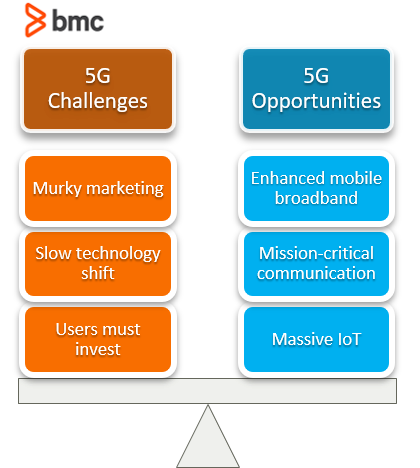Mobile communication services are shaped by customers. And those customers demand:
- High data transfer speeds
- High data volume capacity
- Reliable connectivity
- Low latency
Today, in the era of IT Consumerization, business organizations are rapidly adopting trends such as Bring Your Own Device (BYOD) and Enterprise Mobility. These organizations face increasing demands on enhanced broadband connectivity technologies such as 5G, at least as its hyped by telecommunications providers. We’ve been talking about 5G for years but in 2020, it started to actually appear—and work—at small scale. But a lot of industry experts are weary that 5G is overpromising on something that might be very difficult to deliver.
So, let’s look at:

What is 5G?
Broadband cellular networks follow a set of standards that define the quality of communication service. Parameters include latency, bandwidth density, energy usage, data transmission speed and coverage, among others.
When you compare 5G against the preceding standards of 4G and 4.5G, here’s what 5G offers:
- 10 Gbps data rate (10-100x faster than 4G and 4.5G)
- 1 millisecond latency
- 1000x bandwidth per unit area
- 100x devices connected per unit area as compared with 4G
- 99.999% availability
- 100% coverage
- 90% reduction in network energy usage
- 10-year battery life for low-power IoT devices
How 5G works
The improvements in speed primarily rely on the high frequency band spectrum used for 5G communications. High frequency means that more data can be transmitted between the communication nodes. More data might be good, but the drawback here is that these signals have a shorter wavelength. Thus, the signals cannot travel farther with the same energy compared to low-frequency spectrum waves.
5G today
Mobile operators and hardware manufacturers have already responded to this need by manufacturing and deploying the required equipment at scale, with some regions already rolling out 5G services for the consumer and enterprise market. In the U.S., T-Mobile recently announced a planned expansion of 5G coverage from approximately 30 million to 100 million people—by the end of 2020.
But is it really as promising for enterprise organizations? How can they take advantage of the new technology improvements?
The truth about 5G marketing
The bold claim of 5G is a promise to change the world, from healthcare to computing to gaming. Yet, to this day, that promise has not delivered—despite the advertisement claims of telecom providers around the world.
In fact, the speed improvements are currently expected to be only a 20% increase from current 4G according to some speculation.
The challenges of 5G
This marketing hype draws attention away from challenges that actually prevent users from leveraging the new 5G technology as it is promised:
- Clarity. Marketing departments at telcos will likely overhype the technology that’s not yet transformational at a nationwide consumer-level scale. Yes, 5G can let you download a movie in a few seconds in remote terrains, but will the service itself ever get there? Will telco providers sell a vanilla 5G variant to attract the audience with a service that’s barely 4G (see 5GE)?
- Slow shift. 4G rolled out a decade ago with significantly improved data transfer speed and volume capacity over 3G. Most of the previous 3G infrastructure and mobile devices were already 4G-ready which enabled a swift transition to 4G. 5G, however, is complicated. It’s likely that at least the early versions of 5G will improve upon 4G—but deliver on the promises of a true 5G experience.
- New purchases. To access 5G, you’ll have to invest in new 5G-compatible devices. However, deciding to invest in new 5G technology may be premature. The service is not yet available nationwide. It will likely take time before the true 5G service is rolled out at scale for most users.
5G opportunities for companies
When 10Gbps 5G service is rolled out, by the year 2035, the new technology would have supported:
- 3 million new jobs
- An additional $234 billion investment globally
- $13.2 trillion in global economic output
The technology has laid foundations for new service segments. Let’s look at three new segments of service for 5G—and what opportunities these offer for companies
Enhanced Mobile Broadband
5G will power new immersive experiences through AR/VR. Advanced AI technologies will empower end-users with data-driven services on their devices.
Enterprises can take advantage of intelligent and information-rich services to better engage their consumer base. More accurate and tailored advertisements will lead to better business opportunities locally. mobile and remote working will emerge as a viable solution to address the talent shortage for most tech jobs.
Mission-critical communications
AR/VR capabilities will make remote communications effective for critical functions such as manufacturing, medical procedures, and utility infrastructure maintenance:
- Emergency service agencies will no longer be limited by low-speed data transfer and service coverage issues.
- Unmanned Aerial Vehicles (UAVs) can be effectively deployed for search and rescue operations in remote locations with 10Gbps 5G millimeter wave communications access.
Massive IoT
Compute processing is moving from centralized data centers and coming closer to the edge of the connectivity network, which is densely populated by low power IoT devices. 5G gigabit speed and low-latency wireless connectivity will produce high demand for massive IoT technologies in applications such as:
- Smart manufacturing
- Smart metering
- Environmental monitoring
- Wearable e-health
Devices in small form factors that are sensitive to latency and have low power capacity will be deployed at scale. Anything that can benefit from connectivity can be connected effectively using 5G.
Will 5G deliver?
No doubt 5G will deliver some benefits to some user groups. But will 5G usher in the sweeping revolution the telecom industry has promised? It’s too early to tell. For now, know that 5G has plenty of potential—mostly untested.
Additional resources
For related reading, explore these resources:
These postings are my own and do not necessarily represent BMC's position, strategies, or opinion.
See an error or have a suggestion? Please let us know by emailing blogs@bmc.com.






